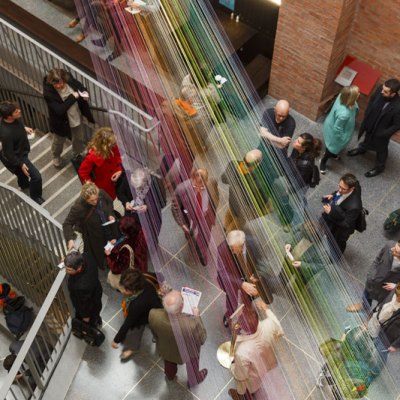Modern Art Oxford is one of a clutch of British art institutions founded in the 1960s. Like Ikon Gallery in Birmingham and London’s Camden Arts Centre, both of which celebrated their half-century last year, the gallery now stands as an international beacon of contemporary visual culture. The Museum of Modern Art Oxford (MoMA) was opened in 1965 by architect Trevor Green, and quickly established a reputation for mounting groundbreaking shows of significant artists, from the UK and abroad. This year Modern Art Oxford (as it has been known since 2002) celebrates its half centenary with a year-long series of evolving exhibitions, collectively entitled ‘KALEIDOSCOPE’ (until 31 Dec).
This title is an attempt to do justice to the more than 700 diverse exhibitions mounted here since the gallery opened. Green’s original intention was to establish a permanent modern art collection. But right from the start, MoMA Oxford was a ‘Space Place’ – as its first exhibition in 1966 was titled – a place for ideas as much as artworks. In 1969 the museum hosted South African artist Roelof Louw’s seminal installation, Location, which consisted of a large, thick black rubber band running around the walls of the upper gallery. Richard Long exhibited in 1971; in 1973, then director Nicholas Serota invited Sol LeWitt to draw directly on the gallery walls. Since then, Joseph Beuys, Hans Haacke, Alexander Rodchenko and Marina Abramović have all had solo shows. In 1986, MoMA showed avant-garde Japanese art, while in 1993 a two-part exhibition introduced audiences to dissident contemporary Chinese art. When the gallery changed its name in 2002 it was an acknowledgement that it was never going to be a museum in the traditional sense: Tracey Emin exhibited neon works, drawings, films and sculpture that same year.
In 2012, the gallery’s talented director, Michael Stanley, died aged 37. It has been the task of his successor, Paul Hobson, to articulate anew the gallery’s purpose. For Hobson, who studied at Oxford University, the gallery’s commitment to engage with ideas, to understand art ‘as a system of visual knowledge’ is fundamental. He is also dedicated to extending the range of artists (particularly women), the gallery shows, and to broadening the way exhibitions are constructed: think of last year’s ‘Love Is Enough’, a joint display of Andy Warhol and William Morris curated by Jeremy Deller. ‘We work really hard not to become an off-shoot of a blue-chip commercial gallery,’ Hobson says. Modern Art Oxford has always mixed disciplines, attempting to reach beyond a narrow art world to the whole city and beyond. The gallery is also there, Hobson emphasises, to serve as a platform for artists: ‘We try to provide an opportunity for artists to find their moment,’ he says. Last year Modern Art Oxford organised the first UK solo show of the Austrian artist Kiki Kogelnik. Once a well-known contemporary of Warhol and Lichtenstein in New York in the ’60s, she was subsequently written out of the history of Pop Art.
This 50th anniversary has been an excuse to dig deep in the gallery’s archives. A random analysis of the many texts produced over the years found that ‘time’ was the most frequently used word – spookily appropriate. As a result, time is a recurring theme in KALEIDOSCOPE. Furthermore, to reflect the multilayered, slippery nature of time, all the artworks will mostly have been shown in the gallery at some point in the past, gathered back for fresh consideration at large expense and logistical difficulty, or are newly commissioned.
Still from ‘De-extinction’ (2014), Pierre Huyghe. Courtesy the artist, Hauser & Wirth, London and Anna Lena Films, Paris

In the first exhibition of the KALEIDOSCOPE programme, ‘The Indivisible Present’ (until 16 April), Douglas Gordon’s terrifying 24 Hour Psycho (1993), the Hitchcock film slowed down to last a whole day (first shown here in 1996), is displayed alongside Yoko Ono’s Eye-Blink (1966; first shown here in 1997), and John Latham’s teasing sculpture The Moral High Ground (1988; first shown here in 1991). Elizabeth Price’s frenetic, complex animation Sleep (2013) is here by virtue of Price’s long association with the Ruskin School of Art, while Pierre Huyghe’s luxurious contemplation of deep time in De-extinction (2014), a film focused on mosquitoes caught in amber, goes on public display here for the first time. Other works in this thoughtful show include New York-based, German artist Viola Yeşiltaç’s exquisite photographs of fragile paper sculptures caught at the moment of falling. These new works are part of the artist’s ongoing series I Really Must Congratulate You on Your Attention to Detail, and probe the borderland between sculpture, photography and performance.
Hobson’s vision for the year is that one exhibition will dissolve into the next, with the gallery never closing, allowing the audience to experience the ‘behind-the-scenes’ process of constructing curated shows. ‘The Indivisible Present’, for example, will slowly transform into the next show, ‘A Moment of Grace’, from 22 March but won’t be fully realised until 16 April. Not a great believer in the false certainties of history, Hobson feels this is the best way to communicate the ongoing recreative energy of this impressive art centre. Happy Birthday Modern Art Oxford!
‘KALEIDOSCOPE’ runs until 31 December and ‘The Indivisible Present’ runs until 16 April, both at Modern Art Oxford.





